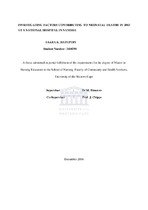| dc.description.abstract | Background: The neonatal period starts at birth and ends 28 days after birth, and is the most defence less period in the newborn's life. Improving newborn health is a priority for the Ministry of Health and Social Services (MoHSS) in Namibia. The national neonatal mortality rate stood at 21.80 per 1000 live births in the country, and Namibia was unable to attain Millennium Development Goal 4 which focused on reduction of the child mortality rate by two-thirds between 1990 and 2015. Aim: This study investigated the factors contributing to neonatal deaths at a national hospital in the Khomas region of Namibia, with the following objectives: (i) to identify causes of early neonatal deaths; (ii) to identify the causes of late neonatal deaths; and (iii) to identify avoidable and unavoidable factors contributing to neonatal deaths. Methodology: The study used a quantitative research approach with a retrospective descriptive design to investigate factors contributing to neonatal deaths. The primary data were collected from a population of 231 record files of all neonates who died during the period 1 January to 31 December 2013 while admitted to the national hospital before 28 completed days of life. Results: The study identified that of the neonates who died, 67.1% (n=155) were early neonatal deaths (during the first 0–7 days of life), while 32.9% (n=76) died during the late neonatal period (from 8–28 days of life). Of the neonates who died, 50.6% (n=117) were male and 48.48% (n=112) were female. The causes of early and late neonatal deaths were similar, although they happened at different stages. The causes of early neonatal deaths have been identified as respiratory distress syndrome (RDS) – 24.2% (n=56); neonatal sepsis – 12.1% (n=28); birth asphyxia – 11.7 % (n=27); congenital abnormalities – 14.7 % (n=34); hemorrhagic diseases of newborns – 3.9% (n=9); and unknown – 0.6% (n=1). Neonatal sepsis caused the highest number of late neonatal deaths 17.7 %,( n=41); followed by RDS – 7.4% (n=17); congenital abnormalities – 3.9% (n=9); birth asphyxia – 3.1% (n=7); birth trauma – 0.4% (n=1); and unknown factors – 0.4 % (n=1). The study revealed that avoidable factors related to healthcare providers had a severe impact on neonatal deaths, while congenital abnormalities were unavoidable factors. Conclusion: The study concluded that most neonatal deaths are related to actions or inactions of the healthcare providers and could be avoided. Recommendations: Based on the results of the study, further research is required to assess the knowledge, skills, and behaviors of the healthcare providers. Training and education about neonatal resuscitation needs to be carried out on a regular basis. | en_US |

